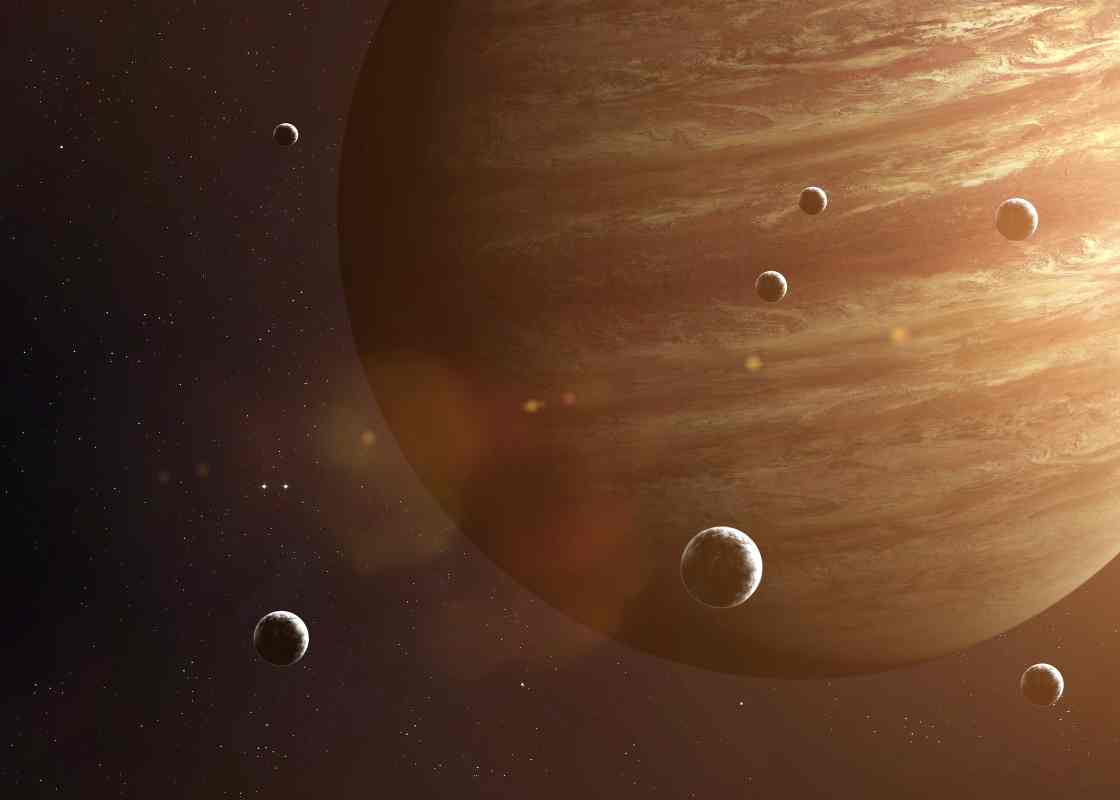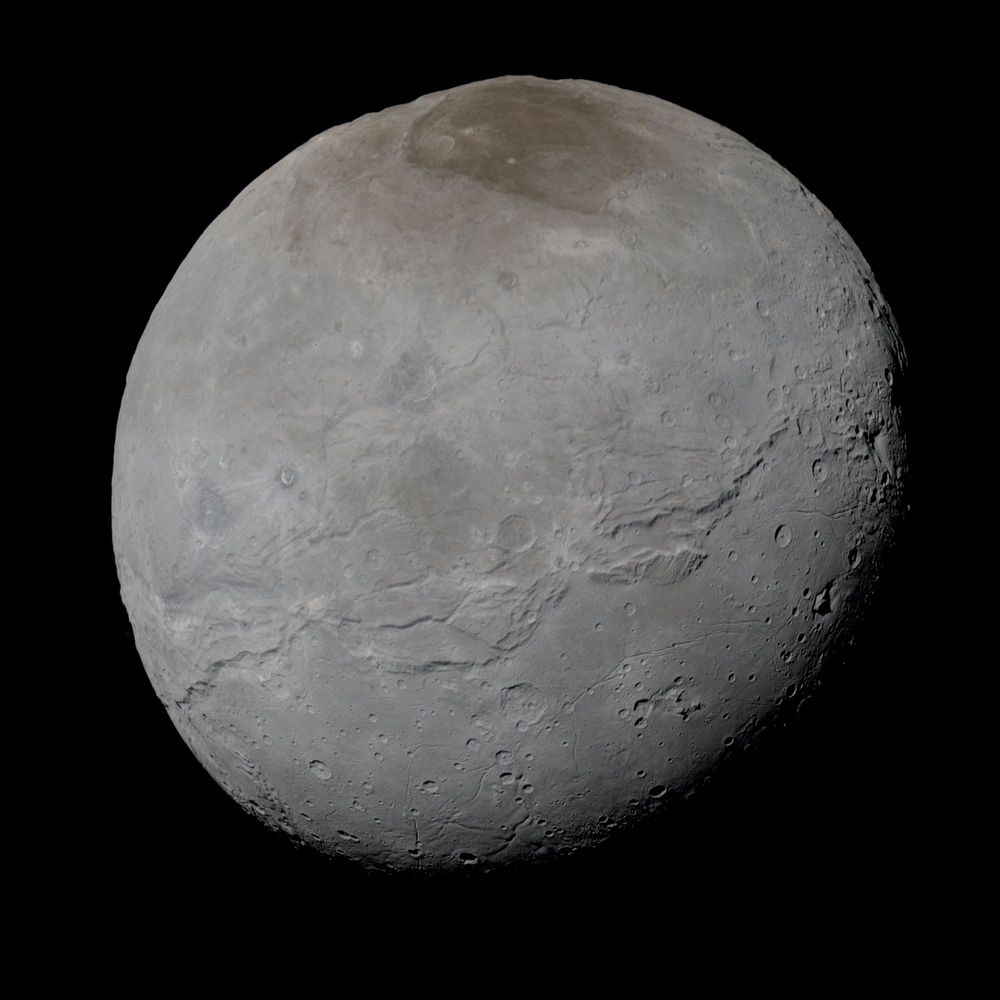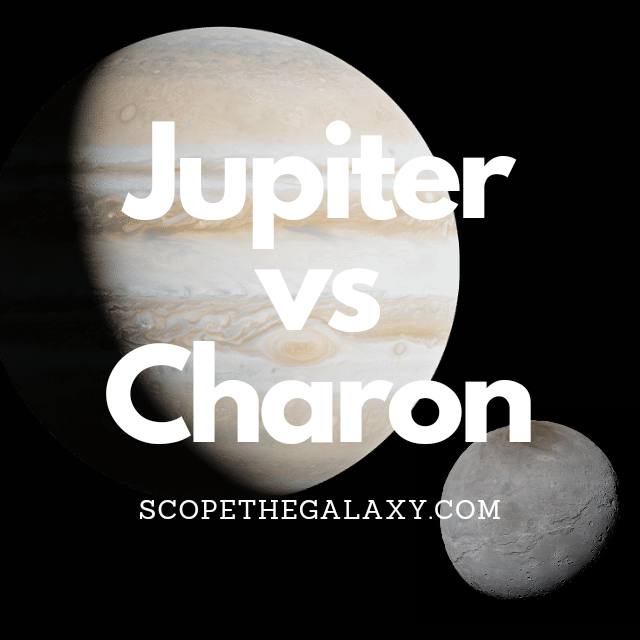*This post may contain affiliate links. This means we may make a commission if you purchase an item using one of our links*
The main differences between Jupiter and Charon is that Jupiter is the largest planet in our solar system with a diameter of 139,820km, is a a gas giant and has 79 moons orbiting it whilst Charon is simply Pluto’s biggest moon with a diameter of 1,212km, is tidally locked to the dwarf planet and and has a practically non-existent atmosphere with a rocky surface.
There are numerous other differences between the two so, continue reading for a more detailed look at each celestial body along with their similarities and differences.
What Is The Planet Jupiter?
Table of Contents

Jupiter is the 5th farthest planet from the Sun and the largest planet within our local solar system. The planets most recognizable trait is the giant red spot visible on its atmosphere along with the brown horizontal bands flowing across its atmosphere.
As a result of its composition and size, Jupiter falls under the classification of a gas giant.
This is because its composition mostly consists of the elements hydrogen and helium. The split is roughly 71% hydrogen, 27% helium, with the remainder of the elements split throughout the left over 2%.
As the biggest planet in our solar system, Jupiter is 139,820 km or 1,300 Earths in diameter, it has a mass of around 0.001 solar masses, the temperature when inside the clouds are roughly -145 degrees Celsius whilst the core is far hotter, equating in the region of 24,000 degrees Celsius.
Due to its extreme circumstances, gaseous composition and distance from the Sun, the planet is not theoretically capable to support life, from its subzero temperature to the extremely fast 640 km/h winds, and its gravity which may be unsustainable for our bones, roughly 2.4 times greater than Earth’s.
Although the conditions on Jupiter aren’t suitable for us, some of its 79 moons like Europa for example could support life.
This brown giant has a relatively fast rotation around its axis where 1 rotation typically takes 10 hours to make whilst its orbit around the Sun is far longer taking in the region of 12 years for 1 full cycle.
Another feature of Jupiter that is renowned by astronomers is the strength of its magnetic field. In comparison to the other planets in our solar system it is even stronger than our Sun, where it’s over magnetosphere is roughly 20,000 times the strength of Earth.
What this means is that Jupiter’s magnetosphere is able to avert solar winds that are 3 million kilometers away from it.
What Is The Moon Charon?

Charon is the largest of Pluto’s moons, first discovered on 22nd June 1978. The surface of this icy world is frozen with nitrogen and methane ice; it may also hold some water ice. While Pluto possesses a reddish hue, Charon is closer to a neutral shade of grey; this suggests the two bodies have different compositions.
Scientists named this moon after the mythical ferryman, Charon, who once carried souls across the Acheron river. This river is one of five legendary rivers that could lie beneath the surface of Pluto.
The formation of Charon remains something of a mystery to scientists. However, this moon may have formed around 4.5 billion years ago when an object traveling at immense speed collided with Pluto. Its average distance from the Sun is approximately 3.6 billion km.
Charon is almost half the size of its planet at 1,212km, where scientists refer to these two bodies as a “double dwarf planet system,” and the chilly temperatures vary from minus 23 to minus 258 degrees Celsius.
Charon takes 153 hours to orbit its planet at an average distance of 19,640km, and it is tidally locked, meaning the same side of the moon always faces Pluto. Pluto also experiences a tidal lock to Charon, so the same two sides always face one another.
Among the fascinating features of this ice moon are the ice volcanoes that could exist on the surface. Observations from the Gemini observatory suggest that Charon could have a form of cryovolcanism known as ice-particle geysers.
The frigid world also has a canyon between seven and nine kilometers deep. (To put that into perspective, Mount Everest has a height of 8.8km).
Similarities Between Jupiter And Charon
There are a few similarities that Jupiter and Charon share, which in this case includes the following:
- Both are a spherical shape.
- Both have a hotter core.
- Both are part of the same solar system.
- Neither have tectonic plates.
- Both orbit another object.
Differences Between Jupiter And Charon
In regards to the differences between the two, they include the following:
- Charon is smaller with a diameter 1,212km compared to Jupiter which is the largest planet with a diameter of 139,820km.
- Jupiter is a gas giant planet whilst Charon is a natural satellite.
- Jupiter orbits the Sun in an almost circular pattern whilst Charon orbits Pluto and the Sun elliptically.
- A day on Jupiter takes 10 hours whilst a day on Charon is 153 hours.
- Jupiter orbits the Sun in 12 years whilst Charon orbits the Sun in 247.78 years.
- Jupiter has an axial tilt of 3 degrees whilst Charon’s axial tilt is straighter in comparison.
- Charon’s average temperature is -23 to -253 degrees whilst Jupiter’s average is -145 degrees Celsius.
- Charon’s atmosphere is near enough non-existent whilst Jupiter is a gas giant composed of hydrogen and helium.
- Charon’s gravity is 0.288 m/s² compared to Jupiter’s that is 24.79 m/s².
- Jupiter’s mass is 1.898 × 10^27 kg whilst Charon’s mass is 1.58×10^21 kg.
- Charon has a density of 1.71 g/cm³ whilst Jupiter’s density is 1.33 g/cm³.
- Jupiter has the strongest magnetosphere in our solar system.
- Jupiter has 79 moons whilst Charon has 0.
- Jupiter has 4 rings surrounding it whilst Charon has 0.
- Charon is tidally locked to Pluto whilst Jupiter is not tidally locked to anything.
Summary
Jupiter and Charon have very few features that are similar other than the fact both are part of the solar system and how both do not have tectonic activity.
However, whether it be in regards to size, mass, physical composition, magnetic field activity and more, Jupiter and Charon are very much distinct in the way they look and in the way they function as whole within our solar system.

